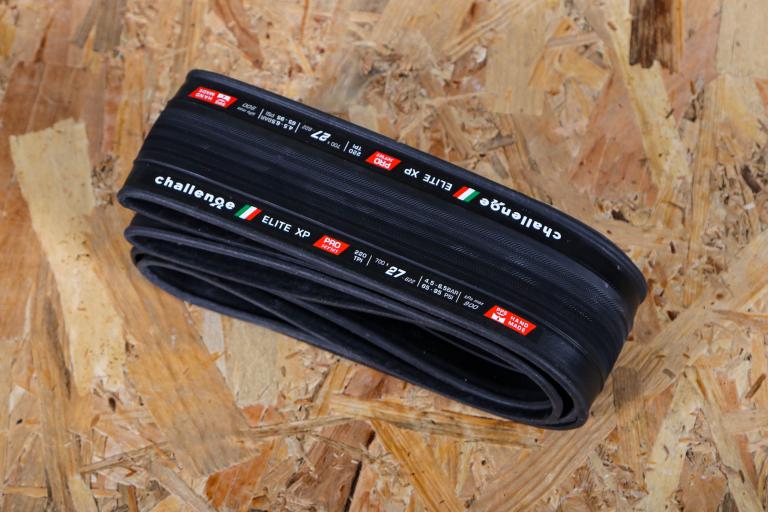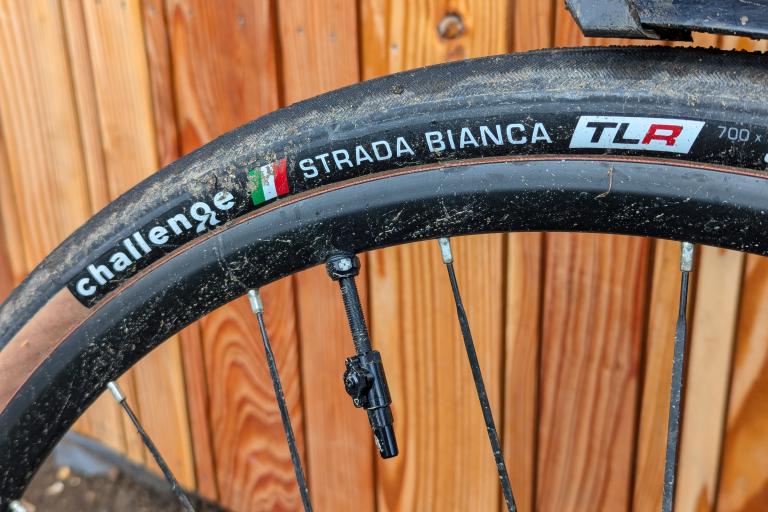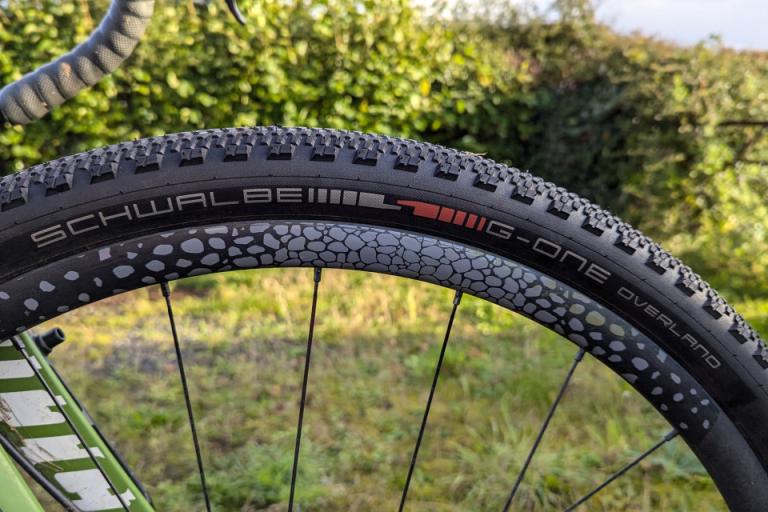- News
- Reviews
- Bikes
- Accessories
- Accessories - misc
- Computer mounts
- Bags
- Bar ends
- Bike bags & cases
- Bottle cages
- Bottles
- Cameras
- Car racks
- Child seats
- Computers
- Glasses
- GPS units
- Helmets
- Lights - front
- Lights - rear
- Lights - sets
- Locks
- Mirrors
- Mudguards
- Racks
- Pumps & CO2 inflators
- Puncture kits
- Reflectives
- Smart watches
- Stands and racks
- Trailers
- Clothing
- Components
- Bar tape & grips
- Bottom brackets
- Brake & gear cables
- Brake & STI levers
- Brake pads & spares
- Brakes
- Cassettes & freewheels
- Chains
- Chainsets & chainrings
- Derailleurs - front
- Derailleurs - rear
- Forks
- Gear levers & shifters
- Groupsets
- Handlebars & extensions
- Headsets
- Hubs
- Inner tubes
- Pedals
- Quick releases & skewers
- Saddles
- Seatposts
- Stems
- Wheels
- Tyres
- Health, fitness and nutrition
- Tools and workshop
- Miscellaneous
- Cross country mountain bikes
- Tubeless valves
- Buyers Guides
- Features
- Forum
- Recommends
- Podcast
review
 Clement Strada LLG tyre
Clement Strada LLG tyre£27.99
VERDICT:
Good all round 28mm winter training tyres; quick, comfortable and grip well at a competitive price
Weight:
275g
Contact:
At road.cc every product is thoroughly tested for as long as it takes to get a proper insight into how well it works. Our reviewers are experienced cyclists that we trust to be objective. While we strive to ensure that opinions expressed are backed up by facts, reviews are by their nature an informed opinion, not a definitive verdict. We don't intentionally try to break anything (except locks) but we do try to look for weak points in any design. The overall score is not just an average of the other scores: it reflects both a product's function and value – with value determined by how a product compares with items of similar spec, quality, and price.
What the road.cc scores meanGood scores are more common than bad, because fortunately good products are more common than bad.
- Exceptional
- Excellent
- Very Good
- Good
- Quite good
- Average
- Not so good
- Poor
- Bad
- Appalling
The Strada LGG 28mm tyres from Clement are smooth-riding, wide tyres with good grip. These 60 tpi versions aren't quite as smooth as the same tyre in a 120 tpi casing, but they've proven hard-wearing.
Wider tyres have become increasingly popular during the last few years with many riders. Switching from 23mm to 25mm allows a lower tyre pressure and adds more comfort. Wider tyres roll faster too, though there's argument in tech circles over whether the extra width and aerodynamic drag negates that.
It's not just tyres either, a number of wheel manufacturers have also moved to wider rims for reasons including aerodynamics and better handling.
You might have also noticed that more and more bike reviews mention whether a frame can fit 28mm tyres. The extra width adds a little more comfort again and the ability to run lower tyres pressures – if your frame can fit them.
Clement is a brand that was has a history dating back to the late 1800's. In more recent times, the brand had lain dormant until its current owners resurrected and relaunched the name with a range of cyclocross tyres.
The Strada LGG is the only road tyre in the range and is available in a number of configurations and weights. There are three widths, 23, 25 and 28mm, each available in either 60 or 120 TPI (threads per inch). You can also get tan sidewall versions of the 25 and 28mm 60 TPI versions if you wish.
The design features an open tread with a built in puncture protection belt and a chevron tread pattern. The LGG name comes from the airport code for Liège in Belgium, home of the legendary Liège-Bastogne-Liège Spring Classic. Nice.
The version on test here has the 60 TPI casing and is 28mm wide. It uses a 70a hardness rubber compound for the entire tyre, which seems like a good idea for the time of year, as it might just provide a tougher construction than the softer compound version.
In theory this should add a bit more toughness and resistance to the general filth of UK roads and lanes at this time of the year. The straight-line grip should be the same on both versions as they run the same compound in the middle on the section of the tyre that's actually in contact with the road.
On the 120 TPI tyres Clement use two different compounds of rubber, the one for the tread (70a), and a softer (60a) compound on the side walls, arguably making for a suppler ride and better grip in corners.
The test bike I've been using had been running a pair of the 120 TPI 25mm Strada LGG tyres and so it was certainly easy to feel a difference in the sidewalls as I swapped them over and fitted them to the bike (and hoped they'd fit our frame and fork, which they did).
Mounting the tyres for the first time was moderately difficult compared to other tyres I've tried recently and the stiff sidewall carcass has to be a factor there. Once they were on and pumped up to the minimum specified pressure of 85 psi I stood back and noted that 28mm tyres look a bit 'pumped up' or sausage-like compared to thinner rubber. A small mental adjustment is required but this should be helped by the adjustment at your backside when you're hopefully enjoying a smoother more comfortable ride.
It's a good time of the year for tyre testing, with the vagaries of the British climate and road conditions providing a true smorgasbord of challenges. I've been riding the Clements on everything from occasional bits of smooth tarmac, to some of the filthiest, muddiest, crater strewn country lanes I could find, including nasty steep climbs and descents to try and wrong foot the Clements.
They've put up a good show. I've managed to get very occasional wheel spin out of the saddle on wet, leaf-covered climbs but most tyres would struggle there.
Moving to 28mm width definitely gives you a more comfortable ride. We've stuck with Clement's recommended minimum pressure of 85psi and they've been just fine. We're sure you could run them a bit lower if you wanted.
If you've not ridden 28mm tyres before, they can feel a bit like you've got a slow flat on the rear tyre at first, such is the softer feel they bring. The benefit of this is that if you're like me, you'll end up holding higher speed over rougher roads. The wider contact patch of the Clements also helped provide good grip on wet, greasy roads and made for a confidence boost on twisty, slippery lanes. Grip was good right from the off too, and improved a little more after the first 30 miles or so.
The Clements don't quite make for an armchair ride, perhaps thanks to the stiffer sidewall of this 60tpi version. That being said, they've done a very competent job of shrugging off horrible winter roads while providing dependable grip, good speed and confidence.
The Clements LGG Strada tyres are decent value too with these 60 tpi versions retailing for £27.99 and the more supple 120 tpi models at £32.99 each. They ride very well for the price. They've resisted cutting up on the worst roads we could find and we've not been visited by the p-fairy either.
Verdict
Good all round 28mm winter training tyre that's quick, comfortable and grips well at a competitive price
road.cc test report
Make and model: Clement Strada LLG tyre
Size tested: n/a
Tell us what the product is for, and who it's aimed at. What do the manufacturers say about it? How does that compare to your own feelings about it?
Clement say that the Strada LGG is a classic road tire featuring the traditional Clement chevron pattern for excellent grip in wet or dry conditions. Inspired by the legendary Clement Criterium Seta, the LGG provides a supple ride, durable yet lightweight construction, and puncture-protection belt under the tread.
The LGG is named after the airport code for Liege, Belgium, heart of the Ardennes and home of Liège–Bastogne–Liège cycle race, the oldest of the classics.
Tell us some more about the technical aspects of the product?
60 TPI is single compound tread 70a
Slightly textured center-tread with traditional Clement chevron side-tread pattern provides excellent grip in wet or dry conditions
Integrated puncture-protection belt
Open tread and lightweight construction
Clincher: folding bead, models range from 220-290 grams
Sizes: 700c x 28mm, 700c x 25mm, 700c x 23m
Rate the product for quality of construction:
8/10
Rate the product for performance:
7/10
Rate the product for weight, if applicable:
7/10
Rate the product for comfort, if applicable:
7/10
Rate the product for value:
8/10
Tell us how the product performed overall when used for its designed purpose
The Clements did a good job, perhaps not as supple as higher their higher TPI model but they rode well and I've enjoyed trying them.
Tell us what you particularly liked about the product
Good grip and comfort ride from the beginning even over awful roads. Wide contact patch made for good handling and cornering too.
Tell us what you particularly disliked about the product
The tyres were moderately difficult to get onto the rims when new.
Did you enjoy using the product? Yes
Would you consider buying the product? Yes
Would you recommend the product to a friend? Yes
About the tester
Age: 46 Height: 180cm Weight: 68kg
I usually ride: Stoemper Taylör My best bike is:
I've been riding for: 10-20 years I ride: A few times a week I would class myself as: Experienced
I regularly do the following types of riding: sportives, general fitness riding, Social, Family and whatever I get talked into
Latest Comments
- mark1a 6 min ago
I was using £500-2000 as the benchmark example given by the previous poster, where they indicated that there were few bikes available in that price...
- chrisonabike 8 min 19 sec ago
Agreed in part but if you really follow that logic then in fact most pedestrian infra needs a change also!...
- mitsky 21 min 27 sec ago
I would not be surprised if Mr Loophole Nick Freeman had something to say.
- Hirsute 43 min 14 sec ago
Will be debated on 31 March https://petition.parliament.uk/petitions/707189
- chrisonabike 43 min 25 sec ago
This is concerning of course. In the interests of fairness / motivating people it might be best if they started transformation from the wealthiest...
- Velophaart_95 1 hour 20 min ago
There are a large number of people who cycle, who've never watched any pro racing on TV.......and couldn't give two hoots about it....
- pockstone 1 hour 21 min ago
While they're at it, they could put a little door on the side of the headtube. You could get a change of clothes in there.
- OnYerBike 1 hour 49 min ago
My interpretation of the law would be that a motor vehicle/EAPC does not stop being a motor vehicle/EAPC just because it has run out of fuel...




Add new comment
10 comments
Well I run GP4000S II @ 25mm as a winter tyre and find them pretty good for grip and fairly fast. So far they're robust too.
My summer set up was Ultremos with 23 on the front and 25 on the rear, which felt faster although they are a bit more fragile and the rear wears pretty quickly. At the moment I'm thinking of going back to Ultremo 23 F&R when the weather warms up.
Might change my thinking if I got a set of fat carbon rims mind...
...thought that I should add that this morning in the wet was one of the few times when I was glad to have the Vreds on my commuter; they are definitely more grippy than the Gators, I've had many brown trouser moments with the Gators in the wet particularly in that most dangerous time just after it's stopped raining and the roads seem to become greasy. I guess I would recommend them for wet weather riding, but who changes their tyres to ride in the rain?!
Can't have grip AND speed I guess...
I'll admit to some confusion in the wider is better debate.
The Tour test report posted above quotes results at constant pressure for the rolling resistance test.
At constant pressure, a wider tyre will as I understand things, deflect less than a narrower tyre, so a reduced rolling resistance is likely. This is because rolling resistance is in large part a measure of the energy taken up in deforming the tyre as it rolls. So fatter = faster, at constant pressure.
However, if as is often suggested, wider tyres are run at lower pressures, deflection and therefore rolling resistance will increase. There is probably a constant deflection vs pressure line that could be plotted which would show wide tyres needing a lower pressure for the same deflection as narrow tyres. (I think Sheldon Brown has something like that). If defection is constant though, it seems unlikely that rolling resistance will vary much. So in practice, fatter does not equal faster?
At lower pressures though the wider tyres would be more comfortable, which might be stating the obvious. So more comfort for the same rolling resistance, which is obviously a benefit, but not necessarily wider = faster?
It's about as clear as mud at the moment innit.
Personally I shall persist with the 28s on my (steel) all weather commuter and 23s on my (carbon) fairweather bike; I'm not quite convinced that fatter=faster, there are so many variables to take into account such as the sidewall rigidity and tread traction which will affect the contact profile with the road.
To be honest, if you want fat tyres (like me) not sure why you would ever choose anything over Grand Prix 4 Seasons.
It would be great if there was a standardised method of assessing a tyre's -
a) rolling resistance (bikeradar did a very good piece http://www.bikeradar.com/gear/article/best-road-racing-tyres-35215/ which compared power used measured in watts)
b) grip (similar method could be used?)
c) puncture resistance
I recently decided to change my commuter from my usual Gatorskins and followed a 4.5 star review rating (from road.cc and Sigma Sport) to choose a pair of Vredestein Fortezza Senso tyres and have regretted it ever since! Slower, no more comfortable, and cannot be more puncture proof!
I'd agree with the puncture-proof bit but slower and no more comfortable.. I find that interesting. Do you mind if I ask what rims, tyre size and pressure the Vredesteins are running at ?
Not at all sir, I bought the 28s I run them at around 90-100Psi. I noticed the extra drag as soon as I'd fitted them compared to the Gatorskins I'd run for the previous 4,150 miles. To be fair they are probably more grippy, and I know that I've been through crushed glass on the road at least twice, but I won't be trying them again, I've already ordered a pair of Gatorskins to replace them. Hope that helps.
Thanks for the info. I was considering them for next autumn/winter, although i'd be running them at rather less pressure - although that would have made them feel a lot slower (run my Vittoria Open Pave 25s at 85/90 front/rear, which seems about optimum for them on wide rims). I'll see if I can nab a go on some before then before I decide on anything.
FWIW I ran 23mm Vredestein Fortezza Tricomps on my Domane and they felt quite a bit slower, almost soft like a marginal puncture, than the Bontragers they replaced however the GPX times showed them to be possibly a bit faster (certainly gripped far, far better). Lovely tyres - but hardly puncture resistant.
Cheers - oh, you thinking about flogging them, or already gone ?
Unless grip is your top priority I don't think I can recommend the Vreds, not when compared to the Gators. I've heard about the Open Paves, never tried any Vittoria tyres though.
I've got a 6 series Project One Domane (great minds!) and run Schwalbe Ultremo ZX HD thingymajigs, over a 1,200 miles, not one puncture; they are the quickest, grippiest, most comfortable tyres I've ever known - they replaced Mavic Grip/Powerlinks which I cannot recommend (not very quick or comfortable!).
The Vreds have covered over 500 miles already (I vary between 110 and 140 miles a week) so I thought I'd keep hold of my buyer's remorse and wear them out! They were on offer at Ribble.co.uk
Since we're on about tyres, I dug this out for you.
http://www.conti-tyres.co.uk/conticycle/download_files/TyreTests/Wide_Ty...
Slightly questionable sample size, and also maybe not impartial, but interesting that the quickest tyres are 28s on this test. The price of the GP4000IIs has sky rocketed since too!
HTH Nick0